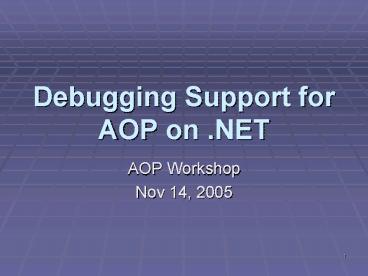Debugging Support for AOP on 'NET - PowerPoint PPT Presentation
1 / 16
Title:
Debugging Support for AOP on 'NET
Description:
Raise awareness about making AOP debuggable. Address some common questions we've been getting (such as EnC AOP, and VS extensibility) ... – PowerPoint PPT presentation
Number of Views:26
Avg rating:3.0/5.0
Title: Debugging Support for AOP on 'NET
1
Debugging Support for AOP on .NET
- AOP Workshop
- Nov 14, 2005
2
Goals
- Its a 15 minute presentation, so lets be
realistic about the goals - Raise awareness about making AOP debuggable.
- Address some common questions weve been getting
(such as EnC AOP, and VS extensibility). - Provide folks with links to further data, so they
can follow-up afterwards.
3
Overview
- What does AOP debuggability mean to an end-user?
- Whats the technical challenge?
- Debuggability for rewriting-IL.
- Debugger Application vs. Platform.
4
What does AOP debuggability mean?
- We dont really know. We work on debuggers. We
have no practical experience with AOP and little
theoretical knowledge ? - What we do know about AOP is that
- Weaving means rewriting the IL
- The end user needs to be able to comprehend the
weaved programs behavior, ideally at the
source-level - We want to learn from you what core functionality
we could enable to make it easier for you to
build best-of-breed AOP tools
5
The Technical Challenge
- Well focus on Rewritten IL at platform level.
- Need to map from Native Code (whats actually
running) ? IL ? Source (what user understands). - CLR JIT tracks the Native?IL maps.
- AOP rewrites the IL, so we need updated IL?Source
maps. - More issues outside scope of this presentation
- What is the ideal end-user model?
- Will need debugger cooperation for AOP-specific
semantics. - May need rewriting concepts that dont exist
today.
6
The PDB (Managed Code)
- Contains IL?Source mappings for line numbers and
local variable names. - Other info (like function names) are in the
metadata in the executable. - Does not allow any additional meta information
like weaved IL - Public read/write API (corsym.idl), private file
format.
7
Options for Rewriting IL
8
Dont use EditContinue (EnC) for AOP
- May not be possible because it Requires AOP
engine to be the debugger. - Only a debugger can do EnC. Detach is disabled in
EnC. - and only 1 debugger can be attached.
- Thus your AOP engine must attach as a debugger to
do EnC which prevents a real debugger from
attaching. - Workarounds
- An extremely extensible debugger.
- Your AOP engine is the debugger.
9
Dont use EnC for AOP (cont)
- (2) Current implementation is poorly suited for
AOP - Unbounded memory usage
- Doesnt pitch old methods or symbols
- Not robust interface in face of API errors.
- Very complicated interface. Difficult to get the
delta IL or pdb blobs. - Consuming EnC is a very large undertaking.
10
Dont use EnC for AOP (cont)
- (3) Many Technical restrictions to not use EnC
for weaving - Only available in V2.0.
- Requires AOP engine to be the debugger.
- Very restrictive edits.
- Can only let you add private methods, fields, and
change method bodies. - Cant add new types, custom attributes or public
members. - Other restrictions. Wont work w/ profiler, ngen,
ref-emit. Wont work in attach-scenarios
(specifically, cant work on code loaded before
debugger attached). Cant detach. - Not intended for production apps.
- Entirely scenario driven by VB IDE requirements.
Eg, expected usage is that you eventually get a
rude-edit and restart the app. - Not stress tested like server scenarios are.
- Must be explicitly enabled, and then has
highly-unoptimized code-gen.
11
Application vs. Platform
- So far, focused on CLR platform issues, thus
apply to all debuggers. - Debugger (including VS) are just applications
that consume the debugging APIs, each has its own
extensibility model. - Use ext. model to get an integrated AOP-IDE
experience (eg, if you want the IDE to grey out
weaved code). - For Visual Studio
- Spectrum Macros / Plug-ins (Tool-windows) / VSIP
- Visualizers allow graphical view into data.
- VS extensions are an entire area in themselves.
- http//msdn.microsoft.com/vstudio/extend/default.a
spx
12
The End
- Contacts
- CLR Debugging (ICorDebug)
- Mike Stall http//blogs.msdn.com/jmstall
- Rick Byers http//blogs.msdn.com/rmbyers
- Jon Langdon jlangdon_at_microsoft.com
- CLR Profiling (ICorProf)
- Jonathan Keljo http//blogs.msdn.com/jkeljo
- David Broman http//blogs.msdn.com/davbr
13
(No Transcript)
14
Bonus Slides
15
Rewriting with CLR Profiling
- Lets you rewrite function body IL
(SetILFunctionBody), supply translation map IL
new ? IL old (SetILInstrumentedCodeMap ). - All done in-place, so no intermediate files.
- Limitations
- Only 1 profiler can attach (may be able to mux
profilers). - Only intended for injecting instrumentation.
- Cant add new fields, types, etc.
- Cant attach.
- Only occur at load. Only edit each method once
(rejit deprecated in V2) - Final pipeline
- Native new ? IL new JIT maps.
- IL new ? IL old from SetILInstrumentedCodeMap
- IL old ? Source From PDBs.
- Profiling API defined in CorProf.idl.
- Complicated unforgiving interface
16
Feature Requests weve heard
- Allow custom information in the PDBs
- Add some sort of general rewriting concepts to
debugging API. - Allow custom attributes to describe a range of
IL within a method. - Contact us if there are other requests!































